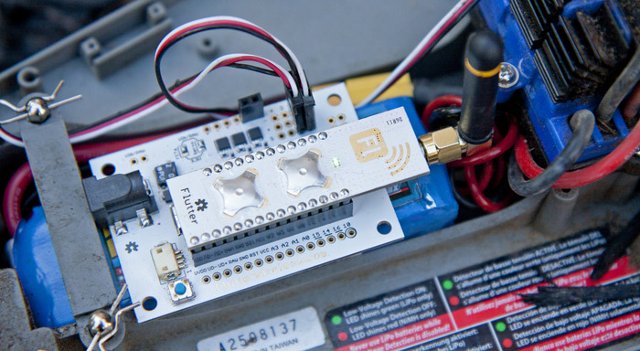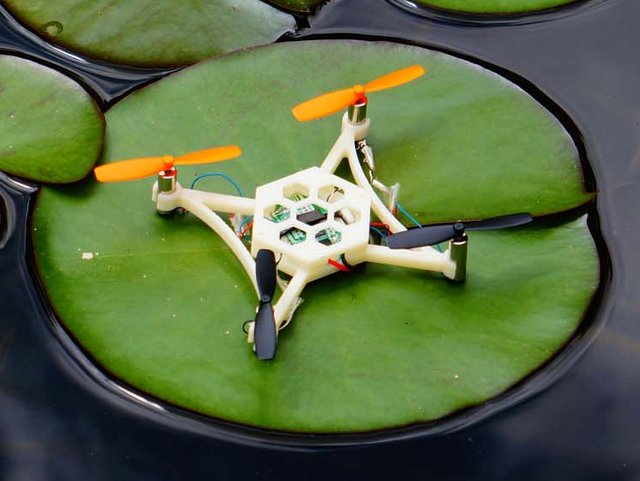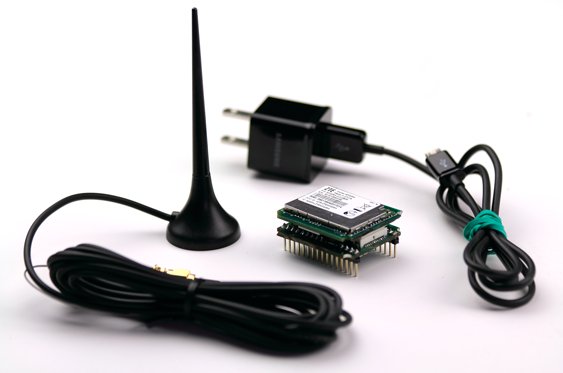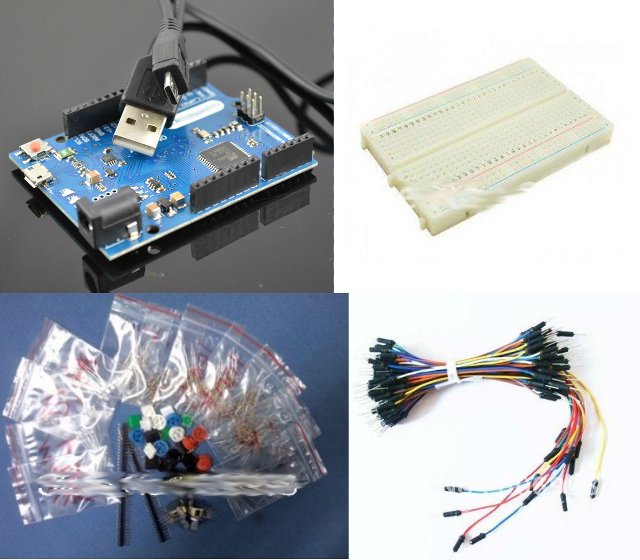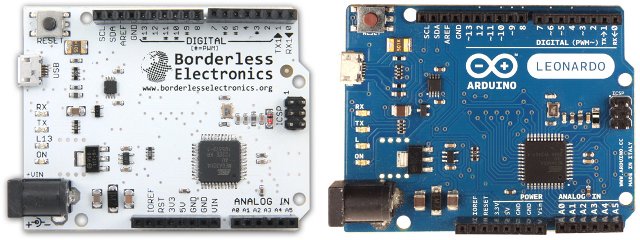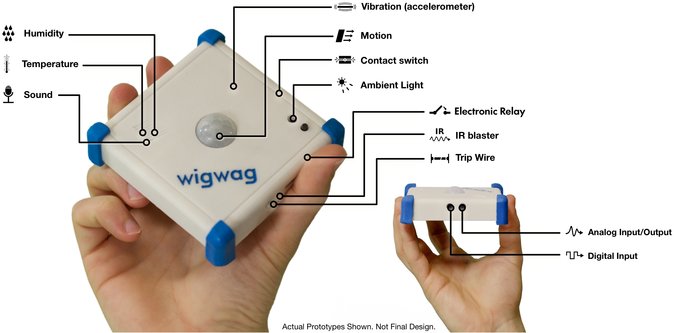There are already several ways to add wireless connectivity to your hardware project. For short ranges, we can use protocols such as Bluetooth (e.g. RFDuino, BLEDuino projects, or Bluetooth USB dongle), for much longer ranges 3G/4G connectivity may be required, and achievable via a 3G/4G USB dongle, or SparqEE CELLv1.0 project for example. But what if you want something in the middle with a range closer to 1km? Flutter boards using the 915MHz band (US only) can provide such range, and are software compatible with the Arduino. There are two version of the board: Flutter Basic – Board with an low-profile integrated antenna. It features micro USB for power, an LED, and a button, as well as several digital and analog I/O. Flutter Pro – Board with external antenna (and probably longer range). It comes with all features found in Flutter Basic, and adds battery charging, an additional button, and […]
$49 (and up) Hex is an Arduino-compatible, Soon-to-be Open Source Nanocopter Kit
Do you remember Mecam, an upcoming $49 nanocopter with a camera? AFAIK, it’s not there yet, but a similar product with a similar price point is now “available” on Kickstarter. Hex nanocopters (quadcopter and hexacopter versions) are not voice-controlled, and do not come with a camera by default, but you can control them with iOS or Android mobile devices, and a camera can be fitted if needed. It comes as a kit, so you’ll have to assemble it yourself, and since it’s fully open source, you could even customize it to your taste. Hex specifications: Propellers – Size: 56×8.5 mm, Fits shaft: 1.0 mm Motors – Diameter: 7.0 mm, Length: 20 mm, Shaft diameter: 1.0 mm, Over 50,000 rotations per minute (rpm) Flight Control System: Flight control – Microwii Copter Processor – Atmel ATMega32u4 Gyro and Accel – InvenSense MPU6050 (6-axis) Battery – 350mAh battery (Flight Time – 7 minutes) […]
SparqEE CELLv1.0 Devkit Adds a SIM Card to Your Arduino, Raspberry Pi, or Other Hardware
There are several ways to add wireless connectivity to your sensors, relays, motors, or other devices. Bluetooth, Zigbee and Wi-Fi can all do a good job for short ranges, and the Weigthless standard will eventually provide ranges up to 10km with ultra low power on free spectrum, but it is not available right now, and a good way to achieve longer ranges is to use cellular networks. SparqEE has designed a development kit called CELLv1.0 to add GSM and 3G connectivity to the Internet of things, including (optional) shields for Arduino and Raspberry Pi boards. Here are some technical specifications for the kit: Cellular Networks – WCDMA/HSDPA 2100/1900/900MHz, GSM/GPRS/EDGE 850/900/1800/1900MHz, 384Kbps, DL3.6Mbps HSDPA via ZTE modem Protocols – Data (TCP/UDP), SMS ready Serial interface – Serial (UART, From Cellular Board is 1.8V, From Jumper board is any voltage (ex. 3.3V, 5V)) USB – (power, USART, and modem) Input Voltage – […]
How to Buy an Arduino Leonardo (Clone) Kit for Less than $20
Borderless Electronics Indiegogo campaign for their $9 electronics kit with an Arduino Leonardo clone went so well that the owner of the campaign decided to limit the total number of boards to 15,000, and basically stop the campaign early to avoid production delays. For $12 ($9 + shipping), you could get a full kit with: Arduino Leonardo clone A mini breadboard with 10 Jumper wires A plug for a 9V battery A few components: 6 LEDs, 10x 330 Ohm resistors, 10x 1 KOhm resistors, 3x push buttons, 2 NPN transistors, 5 diodes, a light sensor, and a sound buzzer A micro USB to USB cable Although they may start a new one campaign in a few months, the campaign is over, and you can’t get this cheap Arduino kit anymore. But one of my reader (onebir) let me know that for less than $20, you can get an Arduino Leonardo […]
Fritzing Open Source Software Designs PCB Layouts from Breadboard Drawings
Earlier this year, I’ve tried Gumstix Geppetto, a web-based application that let you easily design and order boards. You can just add some building blocks in Chrome browser, connect them, and you’re ready to order a PCB. However, the setup fee of $1999 reserves it to businesses. Don’t worry If you’re just a hobbyist as Fritzing, an open source software supporting Windows, MacOS and Linux, allows you to draw breadboard connections, and automatically route the schematics, and the PCB layout. You can then export the gerber files, or order directly from Fritzing Lab. The software is not exactly new, but it’s the first time I’ve come across it. I’m using Ubuntu 12.04 64-bit, so let’s download, install and run the corresponding version:
|
1 2 3 4 |
wget http://fritzing.org/download0.8.3b/linux-64bit/fritzing-0.8.3b.linux.AMD64.tar.bz2 tar xvf fritzing-0.8.3b.linux.AMD64.tar.bz2 cd fritzing-0.8.3b.linux.AMD64/ ./Fritzing |
I’ve decided to connect an LED on the breadboard, and control it with an Arduino Leonardo board to try the software. Alternatively, you could also play around […]
Borderless Electronics Sells $9 Arduino Compatible Starter Kit
The Raspberry Pi fundation, a nonprofit organization, has brought a low cost ARM Linux platform to the masses, and Arduino already did that with electronics, but Harold Timmis, an engineer, found out it was still not cheap enough as he worked as a volunteer teaching electronics at his library. So he (and others) decided to clone Arduino Leonardo, setup a website called Borderless Electronics, and sell it without profit via Indiegogo for just $9 ($12 including shipping). The board is indeed the same as Arduino Leonardo with different color, logo, and name: Microcontroller – Atmel ATmega32u4 @ 16 MHz SRAM – 2.5 KB onchip (ATmega32u4) Flash Memory – 32 KB onchip (ATmega32u4) of which 4 KB used by bootloader EEPROM – 1 KB onchip (ATmega32u4) Operating Voltage – 5V Input Voltage – (recommended) 7-12V | (limits) 6-20V Digital I/O – 20 pins PWM – 7 channels Analog Input – 12 […]
WigWag Simplifies Home Automation, Provides Raspberry Pi and Arduino Shields
WigWag is an home automation kit aiming at simplifying home automation, yet allowing developers to roll their own system via Arduino and Raspberry Pi Shields. Wigwag is currently composed of three devices: WigWag Sensor Block – Universal sensor device with 8 environmental sensors (light, detect motion, sound, temperature, humidity, movement…), 4 control features (relay, IR blaster…), and 2 expansion ports. It can be powered by 4x AA batteries (possibly for up to 1 year), or a USB power adapter. This device runs Contiki OS on Freescale MC1322 MCU (with built-in 6LoWPAN radio). WigWag Relay – Connects WigWag and third party devices to their cloud service, allowing interaction with Internet services, such as email, Dropbox and Twitter. It acts a bit like a central server managing all your WigWag Sensor Blocks or other connected devices such as Phillips Hue light bulbs or Belkin WeMo outlets in your house. IP networks (Wi-Fi & Ethernet) […]
Open Source Prosthetic Arm Controlled By Muscle Movements
Gustavo Brancante is working on a very interesting project that let you control a prosthetic arm with your muscle movement using open source technology with InMoov Hand (which can be 3D printed), Arduino Uno R3, and Olimex Electrocardiography electromiography shield (SHIELD-EKG-EMG). This is called a Myo-Electric Prosthesis. Gabriel wrote a tutorial to use his “open arm” which I’ll summarize here. On the hardware front, you’ll also need a UDP compatible Wifi Shield configured as a UDP server with a fixed IP in the same LAN as the smartphone, and 57600 bps. TouchOSC (for smartphone and Workstation) is used with the following layout for calibration and feature selection. Finally load the program below to your Arduino board: Once everything is connected together, you should be able to do that: The demo looks impressive, but this is still work in progress, and next step will be to use a four channel EMG instead […]


